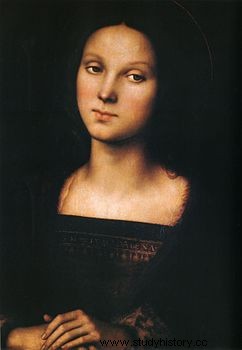
Mary Magdalene in Perugino's pictorial interpretation (around 1500)
Among the characters belonging to the small circle of followers of Jesus of Nazareth , Mary Magdalene, also because she is a woman in sight in a totally masculine world, she is perhaps the one on which we fantasize the most, in the sense that to the already meager historical information provided to us by the Gospels, many later rumors have been added, difficult to verify, above all concerning morality and customs of the woman, which, however, do not find any confirmation in the sources.
Numerous hypotheses have followed over time on the actual role that Magdalene would have in the life of the Nazarene, some of them really suggestive and risky, such as that of considering her the lover or the wife, while a tradition established itself starting from VI century in the West he wanted to see her as a prostitute repentant and redeemed; in reality there are no documents that can attest to the authenticity of the first two statements, which therefore remain relegated to the field of mere suppositions, while there are doubts about the third.
The story of the evangelist Luke informs us that the woman was part of a group of generous benefactors who assisted Jesus and his disciples with their possessions, after being healed from obscure illnesses:Magdalene, it is claimed, was healed of that condition

The apparition of Jesus to Mary Magdalene at the tomb
pathological which was called the seven demons.
The kiss provoked a heated debate among scholars on the lips that Mary Magdalene handed to Jesus, according to what is stated in the Apocryphal Gospel of Filippo (2nd century); the most probable explanation is that there was no erotic meaning in the gesture, but that it constituted only the normal development of a very frequent rite in use in the liturgical meetings of the primitive Church.
In conclusion, we can say that really too little is known about this fascinating female character, one of the most enigmatic and controversial in the entire evangelical history; his origins of her however, at least those, should be implied in the name itself, which in full is Maria di Magdala, a term that could be the errata transcription by Magadàn, geographical location cited by Matteo ( Mt 15:39 ) in which the woman was probably born.
